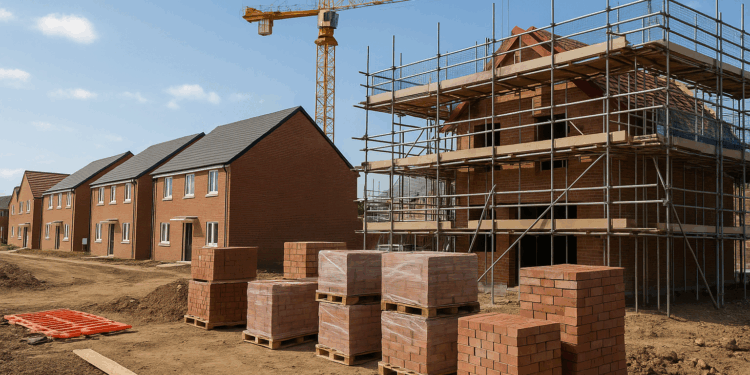Story Highlight
– Steve Reed optimistic about building 1.5 million homes.
– Delays and skills shortages hinder housing development progress.
– Housebuilding projects down 12% year-on-year in August.
– Emergency scheme set for London to boost construction.
– Affordable housing percentage to reduce from 35% to 20%.
Full Story
Housing Secretary Steve Reed has expressed strong optimism regarding the government’s commitment to delivering 1.5 million new homes in England, despite increasing apprehension about potential delays. In a recent interview with BBC Panorama, Reed asserted that he would “absolutely” achieve this target, suggesting that any prevailing scepticism would make the eventual success even more rewarding. He emphasized the importance of accountability, stating, “My job should be on the line if I fail to meet my target. I expect to be held to account.”
Nevertheless, a number of experts have raised concerns about significant challenges facing the housing sector, including a severe shortage of skilled labour and soaring construction costs. Tim Seddon, Chief Executive of Retirement Villages Group, commented that while some advancements have been made, the government is currently not on course to meet its ambitious goals. “The planning system remains slow and inefficient, and there are huge barriers to building that the current legislation does not address,” he noted.
The housebuilding rate has seen a considerable decline this year, despite attempts at reforming the UK’s planning framework. Specifically, there was a reported 12 per cent decrease in housing projects initiated across the UK in August compared to the previous year, with a staggering 44 per cent drop in developments within London. Glenigan’s data revealed only 3,248 new units had begun construction in the capital, far short of the annual goal of 88,000.
Recent findings from the Purchasing Managers Index (PMI) by S&P Global further highlight the bleak conditions within the construction industry. The report indicates that construction output has been decreasing for nine consecutive months, describing it as a “solid rate of contraction.” Business activity forecasts were classified as “subdued,” representing the second-lowest point since December 2022. Steve Mulholland, head of the Construction Products Association (CPA), pointed out the pervasive downturn across the sector, stating, “[The industry] is feeling it now… jobs are finishing and new ones are not starting. We’ve got a real problem.”
The construction sector is grappling with a “huge” shortage of skills and investment, raising serious questions about the capacity to achieve the government’s housing objectives. Although the government has allocated £600 million to help alleviate the skills gap, industry experts claim this amount falls short. Andy Simms, a construction consultant, warned, “There is a huge skill shortage across the whole construction and skilled trades industry, and we rapidly need to train more workers to hit the government’s house building targets and infrastructure initiatives.” He urged the government, as well as educational institutions, to promote the industry as a viable path for young people.
Moreover, Mulholland pointed out that small and medium-sized enterprises (SMEs) are struggling to invest in vital equipment or training due to escalating employer and energy costs, compounded by a lack of investment incentives. He speculated that the industry would be fortunate to reach building targets of 600,000 to 700,000 units this year, expressing a sense of despair about the future.
In a bid to stimulate the housing market, Reed is expected to reveal an emergency scheme as early as next week aimed specifically at London, which faces the highest levels of housing crisis. However, experts caution that the forthcoming measures may do little to facilitate affordable housing. Plans are in motion to reduce the proportion of homes designated as affordable in new developments from 35 per cent to 20 per cent. Simultaneously, rising construction costs will likely drive up prices for the remaining market-rate units.
Furthermore, a significant hurdle affecting London is the Building Safety Regulator, which has left numerous high-rise projects in limbo awaiting approval. While there is a target turnaround time of twelve weeks for applications, many have been awaiting responses for up to a year. Companies like Unite, which specialise in high-rise student accommodations, have also indicated that regulations stemming from the Building Safety Act have extended development timelines by approximately six months, creating additional strain on investments and prolonging the supply of new homes.
Overall, the housing secretary’s assertion reflects a commitment to ambitious housing targets, yet skepticism remains rampant among industry analysts who question the government’s ability to overcome the substantial obstacles currently hindering progress. Seddon remarked, “I’m glad Steve Reed takes Labour’s pledge to build 1.5m new homes seriously enough to put his job on the line. But the housing secretary is overly optimistic.”
Key Takeaways
– Housing Secretary Steve Reed is optimistic about the pledge to build 1.5 million new homes in England, despite concerns over delays.
– Experts cite roadblocks like skill shortages and rising building costs that hinder progress.
– Housebuilding has significantly decreased, with a 12% drop in projects nationwide and a 44% drop in London.
– The construction sector is experiencing a contraction, with subdued business activity expectations.
– An emergency scheme is expected to address housing issues in London, but it may not aid affordable housing.
– The Building Safety Regulator delays approvals, complicating high-rise developments further.






















Delivering 1.5 million homes is a vital target for public health and community wellbeing, but the scale of the recent decline in projects shows the risks are real. Skill shortages, rising costs and tighter safety regulation all affect not just timelines and budgets but the quality and safety of the homes being built. Any push to accelerate delivery must protect standards for fire and structural safety and avoid diluting affordable housing commitments. Investment in training and clear, well resourced regulatory pathways will be essential if these targets are to be met without compromising resident safety.
Ensuring safe, high quality housing must not be sacrificed in the rush to hit numerical targets. Delivering more homes is important, but workforce shortages, rising costs and tighter regulatory scrutiny all point to a need for realistic planning and investment in skills, materials and oversight. Any emergency measures should protect standards and affordable provision rather than undermine them.
Delivering 1.5 million homes is a vital goal for public welfare but it must not come at the expense of safety, quality or the workforce. Reduced project numbers and a shrinking skills pool increase risks on site and could prolong build times if corners are cut. Any emergency measures should include investment in training, support for competent supervision and robust oversight from the Building Safety Regulator so that new homes are safe and affordable.